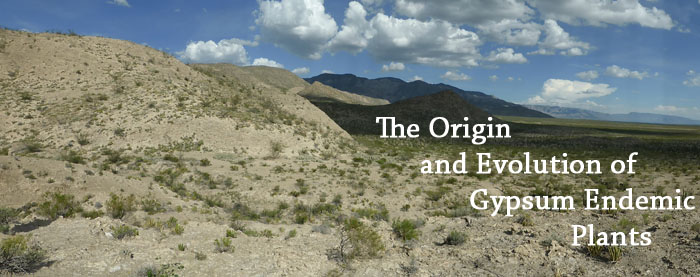
Moore Lab gypsum endemism research featured in the educational video series "Plants Are Cool, Too!"—watch below or read the associated news article:
Edaphic endemism, or the restriction of a plant species to a particular geological substrate or soil type, is a common phenomenon in plants, particularly in the drier regions of the world. In fact, on a global scale, substrate ranks close behind moisture availability and temperature in determining the geographic distribution of plant species.
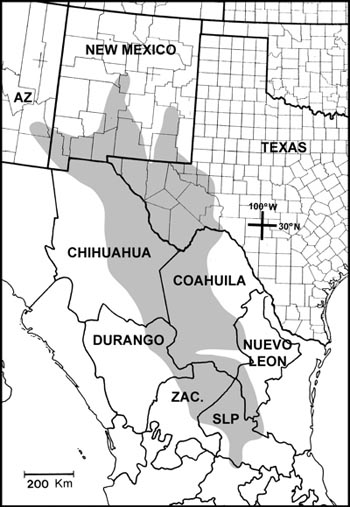 |
Approximate geographic extent of the Chihuahuan Desert (in gray). |
One of the largest edaphically restricted floras in North America is found in the Chihuahuan Desert region of north central Mexico and the southwestern United States. The Chihuahuan Desert is the largest desert in North America, and in spite of its incredible biodiversity, is also the least studied of the major North American deserts. While much of the region is underlain by limestone, gypsum exposures are also a relatively common feature of the Chihuahuan Desert. These gypsum deposits are distributed in a discontinuous, island-like fashion throughout the Chihuahuan Desert region. Gypsum, or hydrated calcium sulfate (CaSO4·2H2O; this is the major ingredient in plaster of Paris and wallboard), is a difficult substrate for plants to germinate and survive on because it typically forms a hard crust when dry, erodes quickly when wet, and is relatively low in available nutrients. Despite the inhospitability of gypsum, a large and diverse group of Chihuahuan Desert plants grow on no other substrate. Examples of these gypsum endemic plants include numerous species within the genera Acleisanthes and Anulocaulis (Nyctaginaceae), Nerisyrenia (Brassicaceae), Nama and Tiquilia (Boraginaceae), Drymaria (Caryophyllaceae), Fouquieria (Fouquieriaceae), Argemone (Papaveraceae), Mentzelia (Loasaceae), Calylophus (Onagraceae), Gaillardia, Sartwellia, Haploësthes, Xanthisma, Dicranocarpus, Marshalljohnstonia, and Strotheria (Asteraceae), Sporobolus (Poaceae), Leucophyllum (Scrophulariaceae), and many others. Scroll down for more text and images of some of these gypsophiles.
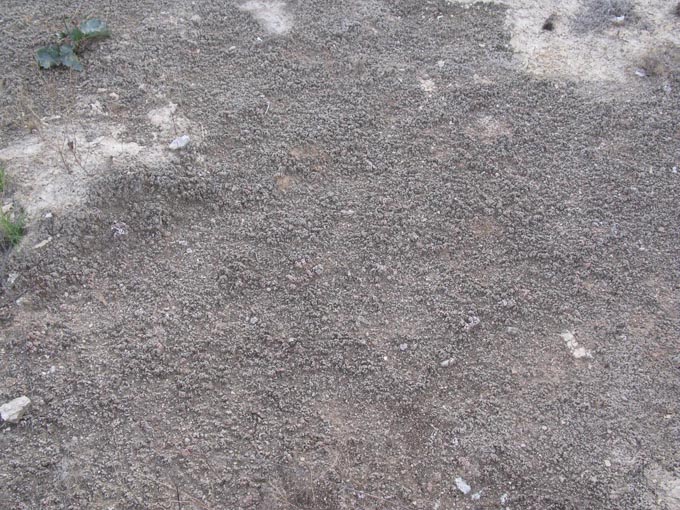 |
Above: Image of gypsum showing surface crust that often forms. |
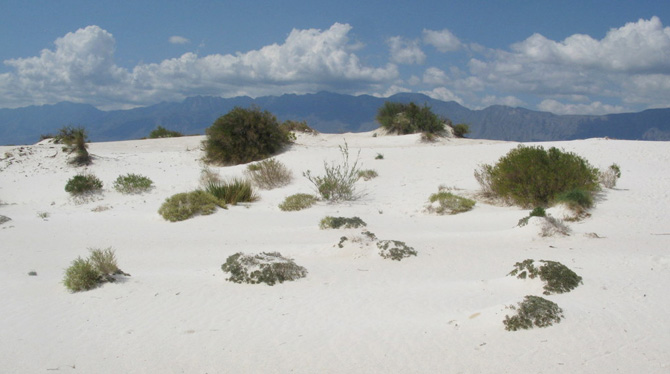 |
Above: Gypsum dunes at Cuatro Ciénegas, Coahuila, México. The plants forming low mounds in the foreground are Tiquilia turneri, a gypsum endemic species. |
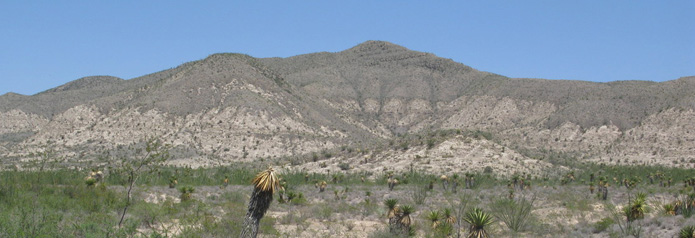 |
Above: Gypsum exposures near the Sierra Amargosa, central Chihuahua. The barren areas on the lower slopes are composed of pure gypsum. |
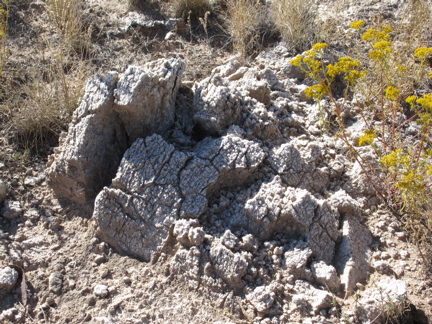 |
Above: Pure gypsum rocks at Chupadera Mesa in central NM. The yellow-flowered plant at right is Sartwellia flaveriae, a gypsum endemic. |
Age of Chihuahuan Desert Gypsum Endemism
Aside from the large number and diversity of species, two other attributes make the Chihuahuan Desert gypsum flora interesting because they suggest that it may be a relatively old assemblage. First, several plant genera in the Chihuahuan Desert have multiple gypsum endemic species within them (examples include Argemone, Drymaria, Gaillardia, Nama, and Tiquilia), and a handful of genera (such as Nerisyrenia and Sartwellia) are composed almost entirely of gypsum endemic species. Within each of these groups, the physical similarities shared among the individual gypsum endemic species suggest that they form a clade; i.e. the gypsum endemic species appear to be each others’ closest relatives. This would imply that speciation (the formation of new species) occurred after these groups became restricted to gypsum. Second, the same gypsum endemic species are often found growing together across much of the Chihuahuan Desert, even though the gypsum deposits these plants inhabit may be isolated from one another by dozens (even hundreds) of kilometers of non-gypsum substrates. Since the only way for a gypsum endemic plant to move from one isolated deposit to another is via chance long-distance dispersal, it makes sense that these gypsum endemic species must be relatively old to account for the time it must have taken for so many of them to have spread so widely.
How can we prove that the gypsum flora of the Chihuahuan Desert is as old as it seems? Unfortunately, fossils do not form well in arid regions, and thus we cannot rely upon a fossil record to determine the age of these plants directly. Instead, we must take a molecular phylogenetic approach. By reconstructing the evolutionary relationships within each of the Chihuahuan Desert gypsum endemic groups using DNA sequence data, we can indirectly estimate the age of gypsum endemic clades and species using molecular dating techniques. Roughly speaking, these techniques involve assessing the amount of DNA sequence evolution that has occurred along an evolutionary branch within a phylogenetic tree, and then converting this quantity to an age through the use of a known time calibration point. Although this method of inferring the ages of lineages is not without limitations, it has been shown to provide useful age estimates in many instances. Scroll down for more.
| Images of gypsum endemic species: | |
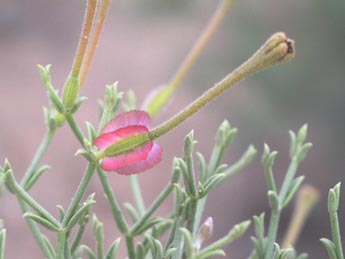 |
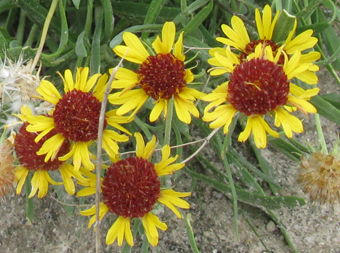 |
| Acleisanthes purpusiana, central Coahuila | Gaillardia multiceps, west Texas |
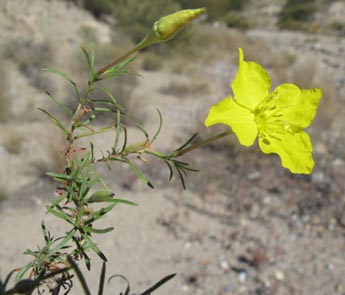 |
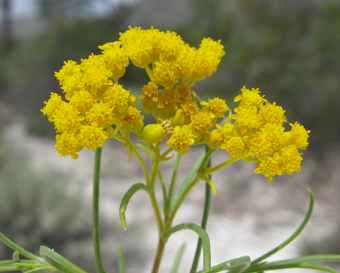 |
| Oenothera hartwegii ssp. filifolia, west Texas | Sartwellia mexicana, Nuevo León |
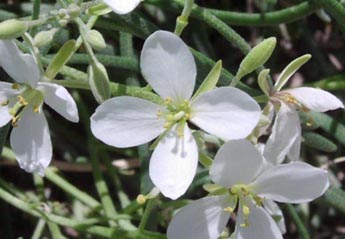 |
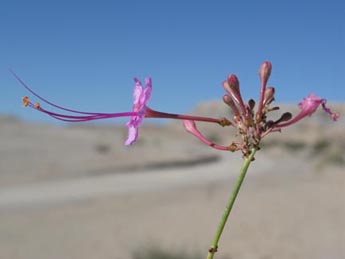 |
| Nerisyrenia linearifolia, southern New Mexico | Anulocaulis leiosolenus var. lasianthus, west Texas |
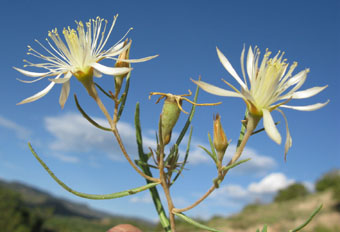 |
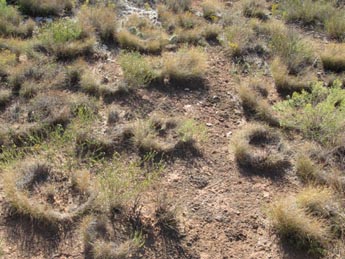 |
| Mentzelia perennis, southern New Mexico | Sporobolus nealleyi (the ring-forming grass in this image), southern New Mexico |
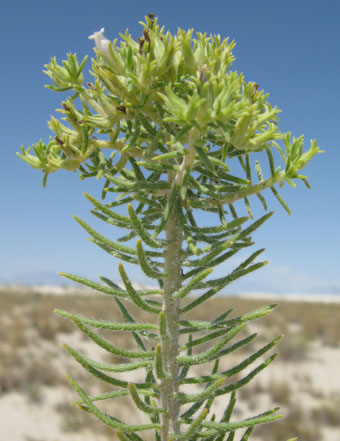 |
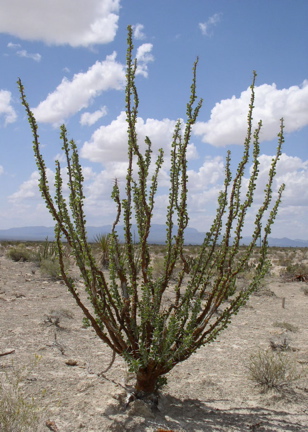 |
| Nama carnosum, southern New Mexico | Fouquieria shrevei, central Coahuila |
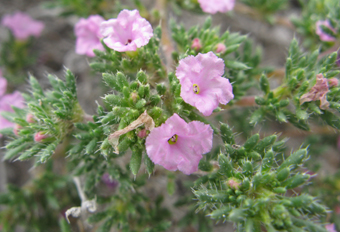 |
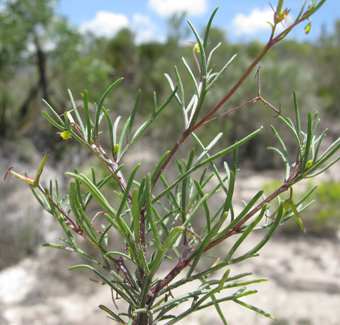 |
| Tiquilia hispidissima, west Texas | Dicranocarpus parviflorus, Nuevo León |
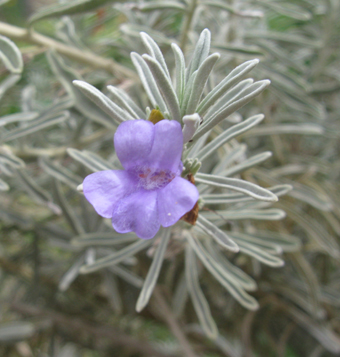 |
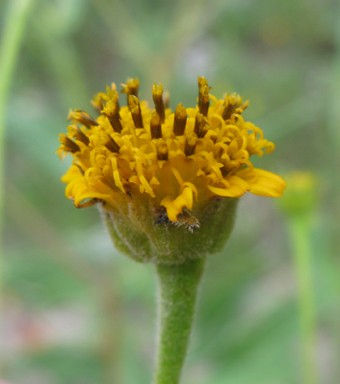 |
| Leucophyllum alejandrae, Nuevo León | Verbesina potosina, San Luis Potosí |
In addition to inferring their antiquity, a molecular phylogenetic approach can also inform us about other elements of the evolution of gypsum endemism. For example, all of the genera that contain multiple gypsum endemic species within the Chihuahuan Desert also contain species that are not restricted to gypsum. Where do the gypsum endemic species within each group fall out with respect to these non-endemics? Do the gypsum endemic species form a clade embedded within a group of non-endemic species (implying a single origin of gypsum endemism—see Scenario 1 below), or are they interdigitated with the non-endemics (implying multiple origins of gypsum endemism—see Scenario 2 below)? The former result would suggest that the transition to gypsum endemism is a relatively rare occurrence, perhaps reflecting the difficulty in adapting to the harsh conditions plants must endure on gypsum, while the latter result would suggest that gypsum endemism is less difficult to attain. Again, we might also expect to see the former result if the gypsum flora is a relatively old one.
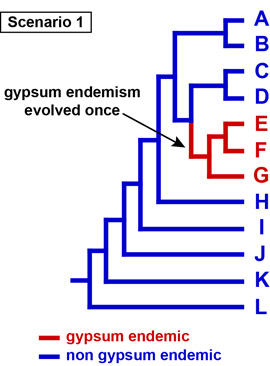 |
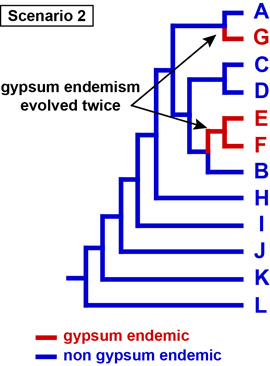 |
Finally, we can use molecular phylogenetic techniques to evaluate genetic diversity within a gypsum endemic species. This becomes especially important for the many widespread gypsum endemics, because we might reasonably expect them to display relatively high levels of interpopulational genetic variation. This hypothesis makes sense because of the isolated nature of surface gypsum exposures in the Chihuahuan Desert; the low likelihood of dispersal between these deposits would promote genetic isolation among gypsum endemic populations. We can test this prediction by searching for DNA sequence variation among individuals from different populations of the same gypsum endemic species.
Current and Future Research
Students in my lab are currently reconstructing the phylogenetic and phylogeographic histories of the gypsum endemic species in 15 different plant lineages in the Chihuahuan Desert, including all of the groups pictured above. Since 2011 our work has been funded by the National Science Foundation and the National Geographic Society. Our early results suggest that the most common and widespread gypsum endemic groups originated in the late Miocene and Pliocene (~5 million years ago). This age corresponds closely with the first onset of relatively dry conditions in the American Southwest that permitted the exposure of gypsum at the surface over broad areas. Consequently, it would appear that almost as soon as gypsum exposures became available for desert plants to occupy, some plants became restricted to gypsum. Moreover, we have found that most widespread gypsum endemic groups display a great deal of genetic diversity that is strongly correlated with geography, exactly as we would expect. We have also found that Mexican populations within widespread gypsum endemic lineages are typically have higher amounts of DNA sequence diversity than more northern populations. Much of this preliminary work has been presented at recent national conferences, and we are working toward publishing these results in the near future.
Further in the future, I would like to explore the ecological origins of gypsum endemism in the Chihuahuan Desert. What kinds of adaptations allow for Chihuahuan Desert gypsum endemics to thrive on gypsum? Do these plants have a physiological requirement for gypsum, or is there some physical characteristic of gypsum substrates that normally prevents germination and establishment, but that gypsum endemics have overcome? To answer these questions will require growing and experimenting with plants on different types of substrates, both in the field and in the greenhouse.
A few Chihuahuan Desert gypsum endemic species (examples include Tiquilia hispidissima and Gaillardia multiceps) have their closest relatives in the deserts of the Colorado Plateau (mainly along the Colorado River and its major tributaries in Arizona and Utah). For more on this, click here.
Last updated on April 9, 2015
All images are the copyright of Michael J. Moore